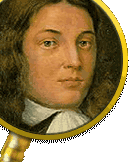More than three hundred years ago, William Penn established a colony based upon his vision of religious tolerance, participatory government, and brotherly love. Penn's unique vision helped shape Pennsylvania and American history, and it continues to affect our lives today.
Continue the Story...
Bring this subject into focus through the following chapters. These stories take exploration of the main story further by providing more detail for you to learn and explore.
Take your students back in history with these discussions and activities for the classroom
|
1609 |
Henry Hudson first explores the Delaware Bay and River |
|
|
1638 |
Swedish establish first trading post on the Delaware River |
|
|
1640 |
Dutch establish trading post at Fort Nassau |
|
|
1644 |
Birth of William Penn |
|
|
1652 |
George Fox starts Quaker Faith in England
|
|
|
1655 |
Dutch troops seize Fort Christina and took control of New Sweden |
|
|
1681 |
King Charles II grants William Penn 45,000 square-mile colony in the New World to pay off debt to Penn's father. |
|
|
1682 |
Penn's arrival in Pennsylvania |
|
|
1682 |
Thomas Holme lays out plan for City of Philadelphia |
|
|
1683 |
Meeting of the first colonial Assembly in Philadelphia |
|
|
1688 |
Mennonites in Germantown issue first protest against the African slave trade |
|
|
1689 |
Penn establishes first Quaker school in Pennsylvania: Philadelphia Quaker Meeting hires George Keith as schoolmaster to supervise local instruction |
|
|
1700 |
Penn and his second wife, Hannah, move to Pennsbury Manor |
|
|
1701 |
Penn meets with the Native people of Pennsylvania at Conestoga Indian Town on the Susquehanna River |
|
|
1701 |
Penn issues the Charter of Privileges, the most liberal constitution of Britain's North American colonies |
|
|
1712 |
William Penn suffers a stroke. His wife, Hannah, becomes acting proprietor until her death in 1726 |
|
|
1718 |
Death of William Penn |
|
|
1728 |
Oneida Chief Shikellamy moves to the West Branch of the Susquehanna to serve as Iroquois's cultural emissary to Pennsylvania |
|
|
1754 |
Outbreak of the French and Indian War |
|
|
1763 |
End of the French and Indian War |
|
|
1763 |
Men from Paxton massacre peaceful Iroquois and other Indians at Conestoga Indian Town |
|
|
1787 |
Organization of the Philadelphia Society for Alleviating the Miseries of Public Prisons |
|
|
1829 |
Opening of the Eastern State Penitentiary in Philadelphia |
|
|
1879 |
Opening of the Carlisle Indian School in Carlisle, PA |
|
|
1917 |
The Religious Society of Friends (Quakers) organizes the American Friends Service Committee to provide alternative service for conscientious objectors to war
|
|
|
1947 |
The American Friends Service Committee wins a Nobel Peace Prize for its relief work in post-war Europe |
|
|
1949 |
40,000 gather at Aaronsburg, Pennsylvania to celebrate the principles of religious toleration and freedom of conscience personified by the actions of Aaron Levy in the late 1700s |
|









